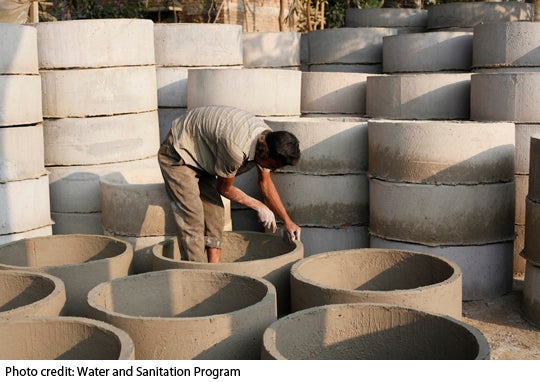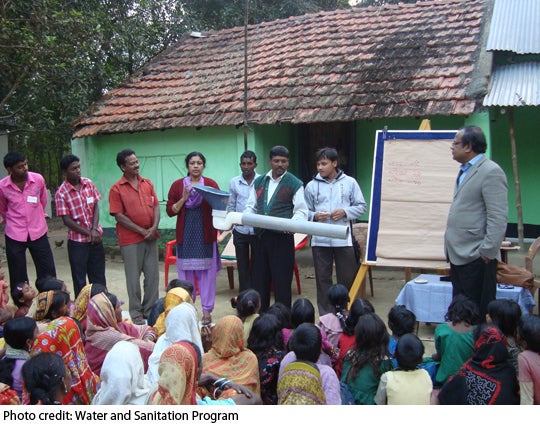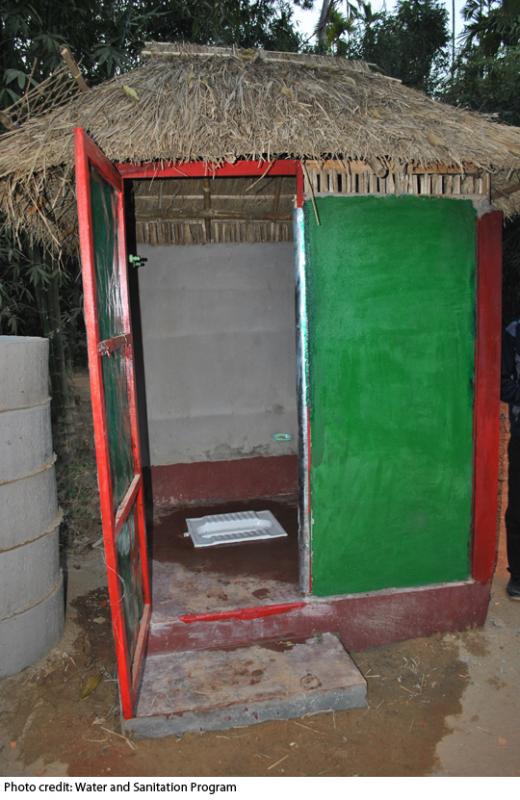Over the last decade Bangladesh has emerged as a global reference for experimenting with and implementing innovative approaches to rural sanitation. And while 90 million people in Bangladesh have moved away from practicing open defecation, diarrheal diseases are still the second-leading cause of child and infant mortality, creating an urgent need for greater availability and affordability of hygienic latrines.
A sanitation marketing program, supported by the World Bank’s Water and Sanitation Program (WSP), is working to improve the sanitation status from low-quality, unhygienic latrines to high-quality, user-friendly latrines like the one being constructed here.

Since Bangladesh is vulnerable to floods and cyclones - which regularly inundate large areas and can destroy improperly-constructed latrines - the design and quality of construction becomes critical and is a key part of the sanitation marketing campaign.

Entrepreneurs also receive specialized training into marketing sanitation products at the community level.

Sanitation marketing teaches entrepreneurs to combine social and commercial marketing approaches to stimulate supply and demand for hygienic sanitation facilities to benefit poor consumers. Here, a woman in Mirzapur Jangai stands in front of her newly-constructed latrine.

By June 2013, the sanitation marketing campaign trained more than 100 entrepreneurs; of them, 71 have already incorporated what they learned into their work and increased their volume of business.

In Bangladesh, rural households that have toilets mainly use direct pit latrines. Most of these lack a water seal and are extremely vulnerable to the floods and cyclonic storms that regularly inundate the areas, destroying the latrines and spilling their contents, which can spread disease.

In 2009, WSP initially launched its sanitation marketing campaign in five villages. Lessons learned through this experience helped refine and further develop the campaign, which has increased the quality of access to improved sanitation significantly in the areas where it operates.

After receiving sanitation marketing training, entrepreneurs like Hafiz Rahman and his wife Salma Begum, seen here, have introduced a hire-purchase system, which has stimulated demand by allowing buyers to pay in installments for their new latrines. In this system, a household typically pays 20 to 50% of the total cost upfront and pays down the balance in weekly or monthly installments, making latrines more accessible to a wider population.

The sanitation marketing program’s training sessions put special emphasis on making toilets more user friendly, including proper sizing, more secure superstructure, door placement, privacy, comfort and convenience.

The ultimate goal of sanitation marketing is to make sanitation available and affordable, particularly for the poor. The sanitation marketing program approaches the issue holistically, taking into account the local socioeconomic context to ensure the development of a sustainable model while providing capacity development support to small, local entrepreneurs already involved in the manufacture of sanitation products.




Join the Conversation